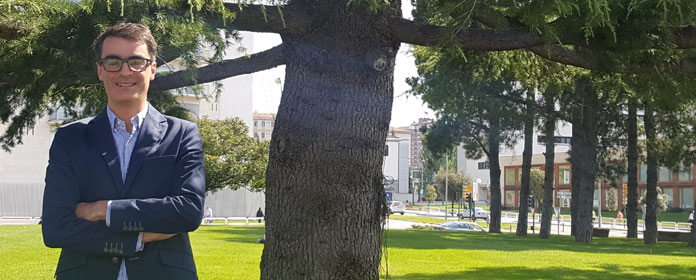Agustín Cárdenas: “Radiología es, de lejos, la especialidad más bonita”
El Dr. Cárdenas trabaja como neuroradiólogo en Estados Unidos

FOTO: Cedida
Aunque ya han pasado los años, “tengo muy buenos recuerdos de la Facultad de Medicina” asegura el radiólogo Agustín Cárdenas, Alumni de la Universidad de Navarra. Ahora vive en Estados Unidos, donde trabaja, con su familia: “En el verano de cuarto de carrera tuve la oportunidad de hacer una rotación (observership) en el Hospital de la Universidad de Georgetown” y allí pudo comprobar una manera diferente de trabajar y aprender, “me parecieron fascinantes los recursos que tenían, el modo en el que se enseñaba medicina y, sobre todo, la increíble autonomía y madurez de los estudiantes”. Fue esa experiencia en la que tomó una decisión “quería venir a trabajar un tiempo a Estados Unidos”. Y desde que acabó, lleva ya cinco años trabajando en Neuroradiología y Radiología General Pediátrica en el Children’sNational Medical Center, hospital pediátrico terciario en Washington DC.
Radiología es una especialidad complicada pero “de lejos, es la más bonita” recalca, “nunca me aburro y aprendo todos los días muchísimo; todo lo que estudio lo puedo aplicar de inmediato en el trabajo diario”. Pero no solo laboralmente: “Desde el punto de vista académico es apasionante, porque todos los casos interesantes acaban teniendo pruebas de imagen”. Todos hemos tenido profesores y tutores que han pasado desapercibidos, sin embargo, hay otros que dejan huella, como por ejemplo el Dr. Biurrun: “Tuve la oportunidad de hacer una rotación con él en el departamento de Radiologíadel Hospital Virgen del Camino de Pamplona, y puedo decir que fue alguien humanamente extraordinario y reconozco que influyó en mi decisión”. También destaca al Dr. Pedro Gil, su tutor durante el primer ciclo de Medicina: “El primer día me reuní con él, me enseñó algo aparentemente trivial, pero que considero desde entonces crucial en el modo de organizar mi vida profesional y personal: a distinguir entre lo urgente y lo importante. Me ayudó a organizarme y a nunca perder la perspectiva”. Consejos que quedan para toda la vida.
Para poder trabajar en Estados Unidos, es necesario realizar el examen USMLE: “Tiene tres partes o Steps. La primera es similar al MIR, tipo test, pero con preguntas centradas en asignaturas del primer ciclo y de ciencias básicas. Es un examen largo y agotador. La segunda se divide en dos partes: un examen tipo test (llamado ClinicalKnowledge) similar al MIR español. La última parte es examen parecido al ECOE (llamado ClinicalSkills) que evalúa competencias clínicas más avanzadas, manejo de pacientes (ambulatorio, ingresados, UCI etc.) y algunos temas de gestión sanitaria.
Este próximo curso, muchos alumnos terminarán sus estudios de Grado y pasarán a una nueva etapa profesional. El Dr. Cárdenas rescata un manual de instrucciones que le recomendaron hace ya un tiempo, como consejos para todos aquellos que se enfrenten al MIR:
-
Escoge la especialidad que te gustaría hacer, en el hospital donde te gustaría hacer la residencia.
-
Toma nota del promedio del mínimo número de orden necesario para poder entrar en ese programa de Residencia en los últimos años.
-
Calcula, con tu expediente académico, el número de preguntas correctas que necesitarías obtener en el examen MIR para poder alcanzar ese número de orden y, por tanto, tu objetivo.
-
Grábate a fuego ese número de preguntas, y dedica los meses de preparación exclusivamente a poder alcanzarlo e incluso sobrepasarlo. Ignora los percentiles, número de preguntas correctas y otras historias de tus compañeros. Las comparaciones son un arma de doble filo, y no aportan absolutamente nada a tu resultado.
-
Haz deporte y descansa al menos un día entero por semana.
Por último, ante la pregunta de si piensa volver a España, responde: “Eventualmente sí”.
